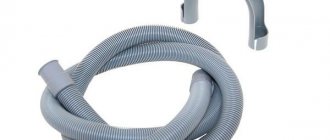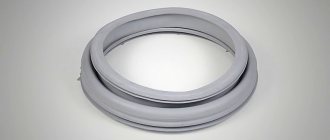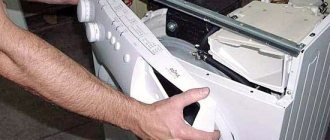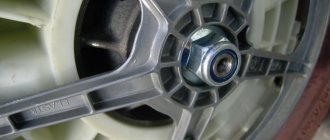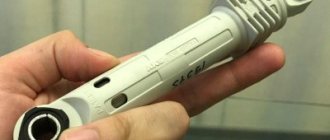Samsung washing machines are modern household appliances that operate for a long time without any problems. Unfortunately, it is almost impossible to manufacture a device in which there is completely no friction between the mating and rotating parts, and in which there is no destruction of the metal from exposure to an aggressive environment. Therefore, sooner or later, parts of the washing machine such as heating elements, belts and the motor will need to be replaced. This article will describe in detail how to replace the heating element in a Samsung washing machine. To perform this operation, no special education is required, and in order to remove the old element and install a new one, it is enough to have a screwdriver and pliers.
Peculiarities
The heating element for the Samsung washing machine is made in the form of a curved tube and is installed inside the tank. The tube is a body in which there is a spiral that conducts current. The base of the housing contains a thermistor that measures temperature. The wiring is connected to special terminals on the heating element.
In fact, a heating element is an electric heater that allows you to turn cold water from the tap into hot water for washing. The tube can be made in the shape of the letter W or V. The conductor located inside has a high resistance, which allows water to be heated to elevated temperatures.
The heating element is covered with a special dielectric insulator, which correctly conducts heat to the steel outer casing. The ends of the working spiral are soldered to the contacts to which voltage is applied. The thermal unit, located next to the spiral, measures the temperature of the water in the tank of the washing unit. Activation of the modes occurs thanks to the control unit, while a command is sent to the heating element.
The element is intensely heated, and the resulting heat warms the water in the drum of the washing machine to the set temperature. When the required indicators are achieved, they are recorded by the sensor and transmitted to the control unit. After which the device turns off automatically and the water stops heating. Heating elements can be straight or curved. The latter differ in that there is a 30-degree bend next to the outer bracket.
Samsung heating elements, in addition to the protective anodized layer, are additionally coated with ceramics. This increases their service life even when using hard water.
It should be clarified that heating elements differ in operating power. In some models it can be 2.2 kW. This indicator directly affects the rate of heating of water in the tank of the washing device to the set temperature.
As for the normal resistance of the part, it is 20-40 Ohms. Short voltage drops in the network have almost no effect on the heater. This is due to high resistance and the presence of inertia.
Causes of breakdowns and failures
The following phenomena may be a sign of heater failure:
- cold water entering the tank;
- increasing the duration of individual stages or the entire cycle;
- the machine stops working a few minutes after drawing water;
- the appearance of a burning smell, the operation of apartment automatic devices (traffic jams);
- electric shocks if you accidentally touch the body of the machine with your hands.
Heavy soiling does not wash well at low temperatures, so the first symptom of a problem is stains on clothes, linen or fabric shoes after washing.
Possible causes of malfunctions are:
- destruction of the heating core or top layer of the heating element, formation of a fistula;
- formation of a thick layer of scale;
- contamination of the tube surface;
- voltage surges in the home electrical network;
- manufacturing defects.
The service life of Samsung machines is 8-12 years. The service life of the heater depends on the hardness of the water, the parameters of the electrical network and the quality of the element itself.
Causes of malfunction
A cold wash indicates a malfunction of the heating element. The machine does not respond to the user’s choice of high temperature mode and the water does not heat up. In Samsung Diamond models, error message H1 appears on the display, and the wash will end prematurely.
The reason for this behavior of the machine:
- Control unit malfunction;
- Temperature sensor malfunction;
- Burnt heating element.
The cause of failure of the heating element is most often the use of too hard water. As a result of washing in hard water, a layer of scale begins to form on the heating element, which prevents its normal heating. As a result, the heater overheats and eventually burns out.
Prevention
To prevent such a situation leading to failure of the heating element, the water must be softened before use. This is done by adding special products, such as Colgon or the like, to the detergent tray.
The use of such prevention is daily, but not the only one:
- When loading things into the drum, you need to ensure their even distribution and quantity. Both the overload of the drum and the unevenness of things in it often cause machine malfunction;
- Do not wash too often at temperatures above 90 degrees. The washing machine will last much less if you often use the boiling mode;
- When putting things into the drum, it is necessary to carefully check the pockets so that small items such as keys, coins, toothpicks and other objects with sharp edges can damage the machine;
- Items that have buckles, metal locks, or large buttons must be washed in a special bag, which you can purchase in a store or sew yourself. Shoes are always washed in such bags;
- Under no circumstances should the washing machine be left unattended for long periods of time while washing.
In this case, if the device gives an alarm signal, the owner will be able to take the necessary measures in time and prevent breakdown. In addition, if a leak occurs, then the likelihood of repairing the premises depends on the speed of taking emergency measures or not; - After each wash, you need to wipe the powder container and leave the loading hatch for ventilation;
- It is advisable to clean the filter after each wash and drain the remaining water through it or through the emergency hose;
- The rubber cuff of the hatch should be wiped dry after washing, avoiding any remaining moisture in its grooves. Otherwise, the rubber of the cuff may tear and will have to be replaced.
Important: when washing, it is not advisable to turn off the machine by de-energizing it. This may lead to failure of the control module
Regardless of the use of products to combat hard water, the machine must be cleaned periodically. This must be done once every two to three years. Dry cleaning should be done once every six months.
To carry out dry cleaning, a special product is added to the washing powder tray. It can be purchased at household chemical stores. After this, the machine must be run without laundry for a long wash cycle at high temperature. As a result, the machine will be cleared of dirt on its internal parts. Unlike mechanical cleaning, chemical cleaning only requires time.
Mechanical cleaning is carried out as follows:
- The top cover, back cover and tray (if present) should be removed;
- The drain pipe is removed and cleaned manually;
- The pump must be removed and cleaned;
- The pipe leading to the tank from the powder receiver must be removed and thoroughly washed;
- The garbage filter must be removed and cleaned;
- The drain and inlet hoses should be removed and washed thoroughly.
How to find a fault?
The tubular heater is located on the flange in Samsung washing machines. The fuse is also located here. In most models from this manufacturer, the heating element should be looked for behind the front panel. This arrangement will require significant effort during disassembly, but you can replace the part if you refuse to work completely independently.
You can understand that the heating element is not working for a number of reasons.
- Poor quality of washing when using high-quality detergent and choosing the right mode.
- When washing, the glass on the door of the washing unit does not heat up. However, this must be checked only after 20 minutes from the start of the process. It is also worth considering that in rinsing mode the machine does not heat the water.
- During operation of the washing machine, energy consumption is significantly reduced. This reason can be verified, but in a very difficult way. First you need to turn off all electrical consumers except the washing device. Then you should record the electric meter readings before turning on the machine. At the end of the full wash cycle, compare them with the resulting values. On average, 1 kW is consumed per wash. However, if the washing was carried out without heating the water, then this figure will be from 200 to 300 W. Once such values are obtained, you can safely replace the faulty heating element with a new one.
Bosch
In a Bosch washing machine, you can also replace the heating element yourself. The process of repairing a household product does not take too much time and is performed in the following sequence:
- Remove the top cover of the device by removing 2 screws located on the back of the device.
- By pressing the central latch, remove the dispenser tray from the front panel.
- Use a screwdriver to remove the control panel screws.
- Detach the bottom panel of the device, which, as usual, is held on only by latches.
- Open the loading hatch and remove the rubber sealing collar.
- Unscrew the bolts holding the door and locking mechanism.
- Remove the front panel.
- Disconnect electrical wires.
- Remove the nut from the bolt located between the electrical contacts.
- Carefully push the bolt inside the tank.
- Using a thin screwdriver, pry up the gasket and carefully remove the heating element from the tank.
The work of removing the heating element has been completed.
Where is the heating element located?
The tubular type heater or heating element in Samsung washing machines is usually located on the flange. The fuse is also located on it. In the event of a breakdown, you can do without contacting a service center if you know how to change the heating element on a Samsung washing machine yourself.
How to check a heating element with a multimeter
To check the heating element you need to know two parameters
- Resistance between contacts 20-40 Ohm (based on power)
- Resistance to housing is at least 20 megohms
If to check the first parameter (resistance between contacts) ANY multimeter or tester capable of measuring resistance within 100 ohms is suitable, then to check the second parameter (resistance to the body) you need a professional device, since a DT830 multimeter (DT832, DT839, etc.) d.) worth up to 1000 rubles. it is impossible to measure resistance within 20-40 Megohm It is impossible to check the heating element with a cheap multimeter A working heating element of a washing machine shows a resistance between the contacts of about 30 ohms, depending on the power, the more powerful the heating element, the lower the resistance will be and vice versa The resistance to the body should be at least 20 megaohms, Moreover, in rare cases, a seemingly serviceable heating element shows this parameter, but when water is added and during operation it begins to break through, i.e. currents are generated that go to the housing, which can knock out an RCD or DIF circuit breaker
How to remove and install heating elements
1. Unscrew the back wall in the Indesit washing machine (Indesit) in our example, or the front wall for LG (Elgie) and Samsung (Samsung) washing machines to access the heating element (TEN) in order to check it and replace it if necessary
2. Unplug the washing machine from the outlet and disconnect the wires before checking with a multimeter, check according to the instructions (see above) and unscrew the nut securing the pressure plate, but not completely, move the rod inside the tank
3. Using two screwdrivers and the lever principle, we remove the old heating element, trying not to damage the tank platform to which the pressure plate is adjacent, since when installing a new heater, water may leak
4. Install a new heating element selected according to the instructions and tighten the nut, install the wires, but do not screw the back wall, start the washing cycle and check the connection between the heating element and the tank for leaks
Dismantling electrical contacts and heating elements
In most cases, the heating element is located under the tank. It looks (or rather, the part with contacts) like an oval block with three contacts and a nut in the middle. The last one is fastening the heating element through the sealing collar.
Before dismantling the heating element, remove the terminals from the contacts, remembering which one was located. Disconnect the ground wire terminal in the center, as well as, by bending the clip in the connector, the block with the temperature sensor wires.
Now it's up to the central nut. Carefully unscrew it, without removing it completely, and press inward. This is necessary so that the rubber cuff compressed inside decreases in profile and ensures free exit of the heater from the installation socket of the washing tank. To push the nut with the stud inside, you may need to tap it with a hammer through some piece of wood so as not to spoil the thread.
After the pin is pushed in, carefully remove the heater from the tank socket. Because The edges of the heating element flange are sharp; it is worth protecting your fingers with gloves in advance. The pulling forces can be quite large and it may be necessary to pry off the sealing rubber with a screwdriver. In this you should be careful and patient, without using excessive force and without damaging the tank and heating element with tools.
Once the element is finally completely removed, the moment of truth comes - the heating element may be in good condition with a clean surface, which indicates high-quality detergents and not hard water. Or there will be a deposit of scale on it, which you will have to get rid of by placing the working part of the tube in a basin with anti-scale. After cleaning the surface of the heater tubes, wipe them dry and remove any contamination from the rubber seal. Now it is like new and can be used again.
If you already guessed that the heater is out of order and have already bought a spare one (usually the heating element is suitable for different models of machines and costs from 600 to 800 rubles), simply replace it by installing it in its original place.
Heater (heater) for washing machine Indesit, Ariston, Hotpoint 1700W, <190mm-195mm>, with hole for sensor
To complete the repair and maintenance, perform all operations in reverse order, tightening the seal nut, screwing the contacts and connecting the ground terminal. Install the cover and screw it in place.
If you encounter other problems with your washing machine, this workshop will allow you to fix other items. For example, you can easily replace a worn drive belt. Or, if the machine does not start, the reason is probably due to worn-out carbons of the electric motor rotor contacts (two rectangular rods on copper wires with springs).
You can easily determine this if you remove them from a special compartment on the machine engine and measure the size of the rods. It should not be less than permissible for a given model of the unit.
- How to fix an LED light bulb yourself: step-by-step instructions
- How to fix headphones yourself: step-by-step guide
- How to repair a smartphone and tablet with your own hands: basic repair details
Photo: manufacturing companies, Andrey Kireev
How to get a heating element for a Samsung washing machine
A feature of these washing units is that the heating element is located directly on one of the outer walls of the tank and getting to it is not always an easy task. But nevertheless, this is not an impossible action. It may seem so only at first glance. Therefore, there is no need to contact a specialist and replace the heating element for a Samsung washing machine at an additional cost. You can do this yourself. Before changing the heating element, you need to disassemble the Samsung washing machine. Here is the order of the work:
- First, we drain the water remaining in the tank; to do this, you need to unscrew the hose with the filter, and the water will flow out;
- then you need to disconnect the front panel of the washing machine by unscrewing the bolts that hold it;
- remove the powder box, unscrew all the remaining fasteners;
- the unscrewed control panel can be moved to the side so that it does not interfere;
- Now you need to carefully remove the sealing rubber around the hatch. This should be done very carefully so as not to damage the cuffs, because it is not easy to replace;
- Use a flat screwdriver to pry up the plastic panel and expose the body of the machine;
- Now the control panel can be unscrewed and pulled out, having first disconnected the harnesses and contacts;
- The front panel can now be easily removed and we can see the inside of the washing machine.
How to replace with a new one?
When it is determined that the heating element is indeed faulty, it is necessary to purchase a new one and replace it. In this case, you need to choose a heating element of the same size and power as the previous one. Replacement is carried out in the following order.
The small nuts on the heating element contacts are unscrewed and the wires are disconnected
It is also necessary to remove the terminals from the temperature sensor.
Using a socket wrench or pliers, loosen the nut in the center. Then press it with an object that has an elongated shape.
Now you should pry the heating element around the perimeter with a slotted screwdriver and carefully remove it from the tank.
It is important to clean the planting nest well. It is necessary to remove debris from the bottom of the tank, remove dirt and, if there is any, remove scale. This should only be done with your hands so as not to damage the body
For better effect, you can use a solution of citric acid.
On a new heating element, you should check the resistance using a multimeter.
To increase the tightness, you can apply motor oil to the rubber gasket of the heating element. The new heater must be inserted into place without any displacement.
The nut is then carefully screwed onto the stud. It must be tightened using a suitable wrench, but without force. All wires that were previously disconnected must be connected to the new element. It is important that they are connected well, otherwise they may burn out. To prevent unwanted leaks, you can “seat” the heater on the sealant.
All other parts must be assembled in reverse order.
If all wires are connected correctly, you can install the panel in place.
After installation is complete, the washing unit should be tested. To do this, you need to run the wash in a mode where the temperature will not exceed 50 degrees. If the washing machine works well, then the problem has been fixed.
Preventive measures
To avoid damage to the heating element, first of all you should carefully read the instructions and use the device as described in it. It is also important to properly care for the unit. For example, detergents should be used only those intended for automatic washing machines.
When choosing, you should pay attention to ensure that the powder and other substances are of high quality, since counterfeiting can lead to significant damage to the device.
Scale forms when water is too hard. This problem is inevitable, so you should periodically use special chemicals to solve it. It is also necessary to clean the internal parts of the washing device from scale and dirt.
Where is the heater located in a Samsung washing machine?
The heating element of the automatic machine is located under the laundry compartment. It is a curved M-shaped tube that connects to the wires inside the device. The configuration of the part determines its name: tubular electric heater (TEH).
In Samsung machines it is located at the front wall, but in some models it can also be located at the back. When checking the heating element, you must first unscrew the fasteners on the rear wall, because Removing the front panel is a more labor-intensive task. To remove the back cover, just unscrew the 4 screws that secure it to the body.
If there is no heater at the back of the car, you need to start disassembling the front part:
- Remove the panel covering the lower front of the appliance. Unscrew the filter and drain the water. Do not remove the filter cover completely.
- Pull out the powder dispenser container, press the button inside the container and pull it out of the opening.
- Unscrew the fasteners located behind the container. Unscrew the screw on the control panel. Slide the front panel without removing it completely.
- Use a thin screwdriver to pry up the clamp that holds the seal between the tank and the loading door. Turn the rubber cuff inside the drum.
- Unscrew the fasteners near the garbage filter. Remove the panel by prying it off with a screwdriver or other thin tool.
- Grab the bottom of the front wall and lift it off the 2 hooks. Move the wall aside to be able to get to the heating element, but do not move it far from the car.
The contacts are located at the end, so there is no need to remove the heater to check conductivity. However, to diagnose a mechanical breakdown (fistula, sediment, etc.), it is necessary to remove and examine the surface of the part.
How to buy the right heating element for a washing machine
Before replacing, you will need to buy a heating element suitable for a specific washing machine. It is recommended to first study the design principle of the heater.
All heating elements are arranged identically inside, but outwardly they are slightly different. The main ones are straight and elongated shapes:
- Direct is most often used and installed in models from the most popular manufacturers;
- Elongated and curved heaters look very similar to straight ones, but if you look 50 mm from the outer bracket, they bend 30 degrees.
The heating mechanism remains alone. Standard resistance is in the range of 20–70 ohms. Extended heating elements are produced based on the design features of some washing machines - these are models Ardo, Ariston, Indesit and others.
Types of Exterior Covering
Most models are covered with a metal shell with a protective anodized coating. It is characterized by high resistance to temperatures, is not afraid of water and protects the heating element from rusting.
A part coated with a special layer of heat-resistant durable ceramics is considered more reliable and durable than metal – even with daily grueling use. Some companies, for example, Samsung, additionally coat their products with this layer.
It is generally accepted that it is more reliable and lasts longer, and prevents the formation of scale when using a source of hard water.
What causes the crash
The first sign of a heater malfunction is washing in cold water (if you select a high temperature mode). The machine washes in cold water due to a breakdown of the water heating system as a whole.
If you, for example, have a SM Samsung Diamond, then error code H1 will appear on the display, and the wash will end early. The reasons may be:
- malfunction of the control unit;
- temperature sensor failure;
- heater failure.
Most often, the heating element fails due to poor water quality. If the water in the water supply system is too hard, when washing at high temperatures, and especially when boiling, scale forms on the heating element.
If you do not carry out periodic preventive maintenance and do not deal with water hardness and scale itself, the layer becomes thicker. Over time, the heat generated by the heating element stops passing through the thick coating, and the heater burns out.
You may not notice it right away, but when the clothes stop washing or the error code comes on, everything will become clear.
Associated works
Before replacing the heating element, it is recommended to check the old one just in case. If it suddenly turns out that it is working, but the machine does not heat the water, then the reason is not a burnt-out heating element. Sometimes there are malfunctions in the electronics unit of the machine.
A tester or multimeter is set up to check resistance. The value in Ohms should be set to the lowest possible on the device.
When checking the heater:
- All wires must be removed from the contacts of the heating element and temperature sensor. You should act carefully so as not to accidentally break the wires;
- The probes need to be connected to the contacts;
- Depending on the tester readings, the situation is assessed: if the device shows a value from 25 to 30 Ohms, the heating element is operational. If the device display shows 1 or 0, then the heater must be dismantled and will have to be replaced.
If you don’t have a multimeter at hand, you can assess the condition of the heating element without it by conducting a visual inspection. If the part is covered with a layer of scale or there are black discolorations on its surface, then in 95% of cases it’s time to change it.
